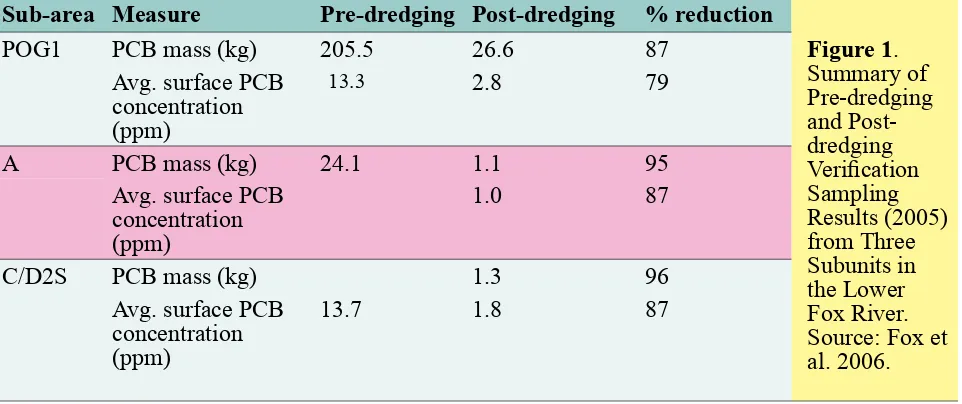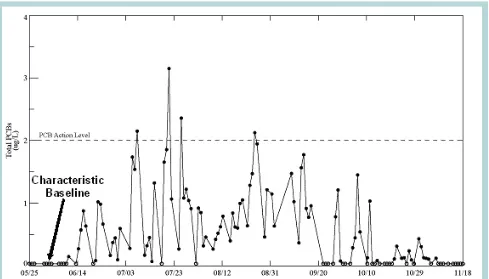Sediment Dredging at Superfund
Megasites: Assessing the Effectiveness
June 2007Dredging is one of the few options available to attempt to clean up con-taminated sediments in rivers, harbors and lakes. However, based on available evidence, dredging’s ability to decrease environmental and health risks is still an open question. Technical constraints, like underwater obstacles, can prevent dredg-ing equipment from accessdredg-ing sediments and dredgdredg-ing can uncover and re-suspend buried contaminants, exposing wildlife and people to toxicants. Evaluating the potential long-term beneits of dredging will require that the U.S. Environmental Protection Agency step up monitoring activities before, during and after individual cleanups to determine whether it is working there and what combinations of tech-niques are most effective.
S
ome of the nation’s estuaries, lakes and other water bodies contain contaminatedsediments that adversely affect ish and wildlife, which may then ind their way
into people’s diets and carry negative health impacts. At least 14 states contain large contaminated sediment megasites, which are expected to cost over $50 million to clean up, that are particularly challenging to remediate. Private
companies are responsible for the cleanup at some sites and the U.S. Environmental Protection
Agency (EPA) takes the lead in managing remediation at others.
At the request of Congress, EPA asked the Na-tional Research Council (NRC) to address the
technical challenges posed by the need to reduce risks at sediment megasites by form-ing a committee to evaluate dredgform-ing as a cleanup technique.
Clean Up Options at Superfund
Megasites
The EPA Superfund program was established more than 25 years ago to ad-dress sites contaminated with hazardous chemicals. The program relies on surveys
and scientiic sampling of sediments under
water bodies to assess the extent of the contami-nation and to explore ways of cleaning it up.
under-Sub-area Measure Pre-dredging Post-dredging % reduction Avg. surface PCB
concentration (ppm)
13.3 2.8 79
A PCB mass (kg) 24.1 1.1 95
Avg. surface PCB concentration (ppm)
1.0 87
C/D2S PCB mass (kg) 1.3 96
Avg. surface PCB concentration (ppm)
13.7 1.8 87
water shovel to relying on natural processes to cover the contaminants and monitoring them to ensure exposures are decreasing, to covering them with a cap of clean sediment material. Of-ten, a combination of techniques is used. In the best cases, dredged sites are also monitored to evaluate how well a remedy is working. Because of the complexity of these megasites, they often become major engineering and public works projects that sometimes take decades to com-plete.
Under Some Conditions Dredging Can
Be Effective
The report’s authoring committee found evidence that dredging can be effectively imple-mented under certain conditions but that tech-nical limitations often constrain its ability to achieve cleanup objectives. Underwater obsta-cles like rock formations, old piers, or hard bot-tom material may restrict the ability of dredging equipment to get at the contamination in some locations, reducing the likelihood that dredging will be effective.
The lack of long-term monitoring
informa-tion at most dredged sites makes it dificult to
evaluate the outcomes of dredging efforts. The committee’s analysis of pre-dredging and post-dredging at about 20 sites found a wide range of outcomes in terms of surface sediment con-centrations of contaminants: some sites showed
increases, some no change, and some decreases
in concentrations. In addition, the dificulty of
separating the effects of dredging from the ef-fects of natural processes that may also decrease sediment risks makes it unclear whether dredg-ing alone has been effective in reducdredg-ing health risks.
About one half of the 20 sites evaluated by the committee either did not achieve remedial
goals or monitoring was insuficient to assess
dredging performance. Remedial goals were met at about 25 percent of the sites, and at another 25 percent of them, not enough time had elapsed to form a judgment.
However, evidence suggests dredging can be effective under some conditions. The right
hand column of Figure 1 shows signiicant
reductions of polychlorinated biphenyl (PCBs) concentrations in three areas of the Fox River megasite in Wisconsin as a result of dredging. However, despite removal of most of the con-tamination, in some cases it was not reduced down to the risk-based cleanup goal for average surface concentrations of 1 part per million of PCBs (see “Post-dredging” column second from right).
Incomplete Removal and Resuspension
of Contaminants are a Drawback
The report inds that dredging alone has not
Figure 2. PCB concentrations in water samples collected approximately 0.5 miles downstream of the dredging operations in the Grasse River. Dredging began approximately June 8, 2005 and ended October 21, 2005. Source: Connolly et al. 2006.
Dredging can permanently remove contaminants from a water body. However, it has the potential to create additional exposures by stirring up bur-ied toxicants and creating residual contaminants in the short-term.
Because dredging activity can re-suspend contaminants as sediments are removed, water
quality, ish and other organisms can be ad -versely affected. Figure 2 below illustrates very low levels of PCBs in the water of the Grasse River in New York until dredging began in June of 2005. At that point, re-suspension of the sedi-ment led to spikes in PCB concentrations, posing risks to wildlife and people exposed to the water that may not have arisen if the river bottom was not stirred up in the process. When dredging ceased, the data show that levels tapered off. Such phenomena have been observed at many other sites.
It is possible these short-term risks could have been avoided if environmental managers had decided not to dredge. But such an option must be weighed against the risks associated with leaving the contamination in place
includ-ing the conidence decision makers have that the
contamination that remains would not resurface
and put isherman and boaters at risk in the future as a result of looding or severe storm
events.
Speciic conditions at a megasite, such as water low rates, the depth and extent of the contaminants, and other factors, inluence the
effectiveness of dredging. The report emphasizes the importance of adequately characterizing potential dredging sites so that adverse or condu-cive site conditions can be considered in arriving at cleanup decisions.
Centralized Dredging Data and
Flexible Management are Key
The report recommends that EPA allow for
more lexibility in how it manages megasite
Committee on Sediment Dredging at Superfund Megasites: Charles O’Melia (Chair), Johns Hopkins University; G. Allen Burton, Wright State University; William Clements, Colorado State University; Frank Curriero, Johns Hopkins Bloomberg School of Public Health; Dominic Di Toro, University of Delaware; Nor-man Francingues, OA Systems Corporation; Richard Luthy, Stanford University; Perry McCarty, Stanford University; Nancy Musgrove, Management of Environmental Resources; Katherine Probst, Resources for the Future; Danny Reible, University of Texas, Austin; Louis Thibodeaux, Louisiana State University; Donna Vorhees, The Science Collaborative; John Wolfe, Limno-Tech, Inc. The project director was Karl Gustavson.
This report brief was prepared by the National Research Council based on the committee’s report. For more information or copies, contact the Board on Environmental Studies and Toxicology at (202) 334-3060 or visit http://nationalacademies.org/best. Copies of Sediment Dredging at Superfund Megasites: Assessing the Effectiveness are available from the National Academies Press, 500 Fifth Street, NW, Washington, D.C. 20001; (800) 624-6242; www.nap. edu.
This study was supported by funds from the U.S. Environmental Protection Agency.
Permission granted to reproduce this brief in its entirety with no additions or alterations.
© 2007 The National Academy of Sciences
measures, such as removal of a certain amount of material from a site. Each site has different
characteristics that inluence the effectiveness
of various remedial options and improved site characterization will aid cleanup planners. Early indications about how well the methods used are working can then be used to adjust approaches to optimally reduce public health and environ-mental risks.
To support more lexibility in EPA sediment
site management, the report recommends that EPA improve its pre-dredging characterization of sites, centralize sediment-related activities in
its remediation ofices, and improve site-track -ing and monitor-ing.
Stepping Up Monitoring Activities Will
Enhance Decision Making
The report inds that monitoring efforts have been poor at many sites, making it dificult to
know how well different clean up methods work and to what extent short- and long-term health risks have been reduced.
The report therefore urges EPA to step up its monitoring activities before, during and after dredging efforts at all sediment megasites to determine whether cleanups are working and to build knowledge of what cleanup techniques are effective under various conditions. Gather-ing more long-term information about how well various methods work will aid future planning and management of these sites.
Dredging remains one of the few options available for the remediation of contaminated sediments and it should be considered, along with other options. To improve cleanup
deci-sions, oficials will need a variety of new types

